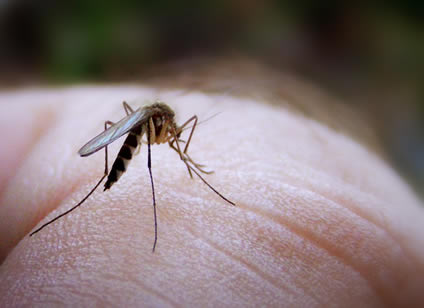|

by April McCarthy
May 10, 2012
from
PreventDisease Website
|
April McCarthy is a
community journalist playing an active role reporting
and analyzing world events to advance our health and
eco-friendly initiatives. |
Pesticides, herbicides and fungicides
dominate agricultural practices for killing just about anything that
is unwanted or interfering with the healthy growth of plants and
crops. However, lower scale operations should never resort this
poisoning of nature.
Some of the earliest written documents
on gardening discuss the relationships between herbs and companion
plants. When selecting your companion plants you will need to
consider more than which pests are deterred.
Think about what each plant adds or
takes away from the soil and what effect the proximity of strong
herbs may have on the flavor of your vegetables.

In nature, there is only balance.
When there is unbalance, nature quickly
shifts course to maintain and regulate its environment so that all
organisms may live and reproduce as required by a given ecosystem.
The important thing to remember when you are trying to get rid of
the "bad" pests is that there are many good insects, such as lady
bugs, bees and butterflies, which may be killed by commercial
poisons - even if it was not your intention.
There is always a way to deter pests.
For example, ants hate
cucumbers, especially cucumber peels. You'll especially appreciate
that fact if you want to get rid of them. Just spreading some
cucumber peels (the more bitter, the better) where ants enter your
garden or home will repel them.
Consider cucumber the "anti-welcome" mat
for ants. Cucumbers are one example of natural pest control.
Another thing to bear in mind is that even though a pesticide may be
organic, it still might harm beneficial insects. The happy balance
is attained when you use natural pest control using herbs and
companion plants to together to deter only the specific pests and
lets the beneficial insects live.
An important note when planting any of the below is to try to avoid
placing two heavy feeders or two shallow rooted plant types near
each other.
|
Herb |
Companions |
Pests Repelled |
|
Basil |
Tomatoes
Dislikes
Rue |
Flies, Mosquitoes |
|
Borage |
Tomatoes, Squash,
Strawberries |
Tomato Worm |
|
Caraway |
Plant
throughout the garden to loosen the soil.
Avoid
Dill |
|
|
Catnip |
Eggplant |
Flea Beetle, Ants |
|
Chamomile |
Cabbage, Onion |
|
|
Coriander |
|
Aphids |
|
Chervil |
Radish |
|
|
Chives |
Carrots |
|
|
Dead Nettle |
Potatoes |
Potato Bug |
|
Dill |
Cabbage
Dislikes
Carrots and Caraway |
|
|
Fennel |
Most plants dislike this herb |
|
|
Feverfew |
roses |
attracts aphids away
from roses |
|
Flax |
Carrots, Potatoes |
Potato Bug |
|
Garlic |
Roses, Raspberries |
Japanese Beetle,
Aphids |
|
Horseradish |
Potatoes |
Potato Bug |
|
Henbit |
|
General Insect
Repellent |
|
Hyssop |
Cabbage,
Grapes
Dislikes
Radishes |
Cabbage Moth |
|
Lavender |
|
Moths — combine with
southernwood, wormwood and rosemary in an
anti-moth sachet |
|
Marigolds |
Plant throughout the
garden |
Mexican Bean
Beetles, Nematodes, others |
|
Mint |
Cabbage, Tomatoes |
White Cabbage Moth,
aphids, flea beetles |
|
Mole Plant |
|
Moles and Mice |
|
Nasturtium |
Radishes, Cabbage,
Cucurbits, fruit trees |
Aphids, Squash Bugs,
Striped Pumpkin Beetle |
|
Pennyroyal |
Roses |
Flies, Mosquitoes,
Fleas, others |
|
Petunia |
Beans |
|
|
Pot Marigold |
Tomatoes |
Tomato Worm,
Asparagus Beetles, others |
|
Pyrethrums |
|
Use dried flower
heads as a general insect repellent. |
|
Rosemary |
Cabbage, Beans
Carrots, Sage |
Cabbage Moth, Bean
Beetle, Carrot Fly |
|
Rue |
Roses and
Raspberries
Dislikes
Sweet Basil |
Japanese Beetles |
|
Sage |
Rosemary,
Cabbage, Carrots
Dislikes
Cucumbers |
Cabbage Moth, Carrot
Fly, Flea Beetle, Slugs |
|
Southernwood |
Cabbages |
Cabbage Moth |
|
Sowthistle |
Tomatoes,
Onion, Corn
Plant in
moderation |
|
|
Summer Savory |
Beans |
Bean Beetles |
|
Tansy |
Fruit Trees, Roses,
Raspberries |
Flying Insects,
Japanese Beetles, Striped Cucumber Beetles,
Squash Bugs, Ants, Flies |
|
Thyme |
Cabbage |
Cabbage Worm |
|
Wormwood |
|
Plant as a border to
keep animals out of the garden. |
|
Yarrow |
Plant near aromatic
herbs to enhance production of essential oils. |
|
|
Natural Insect
Repellent Recipe
Need a natural insect repellent without
DEET? you'll get a more
effective repellent if you combine a few different insect-repelling
natural oils.
If you are making large amounts of
insect repellent, a good rule of thumb is to mix the repellent so
it's 5-10% essential oil, so mix 1 part essential oil with 10-20
parts carrier oil or alcohol.
For a smaller batch use:
The essential oils that work well
against biting insects (mosquitoes, flies, ticks, fleas) are:
-
cinnamon oil (mosquitoes)
-
lemon eucalyptus or regular
eucalyptus oil (mosquitoes, ticks, and lice)
-
citronella oil (mosquitoes and
biting flies)
-
castor oil (mosquitoes)
-
orange oil (fleas)
-
rose geranium (ticks and lice)
Safe carrier oils and alcohols include:
-
olive oil
-
sunflower oil
-
any other cooking oil
-
witch hazel
-
vodka
Mix the essential oil with the carrier
oil or alcohol.
Rub or spray the natural insect
repellent onto skin or clothing, using care to avoid the sensitive
eye area. You'll need to re-apply the natural product after about an
hour or after swimming or exercise. Unused natural insect repellent
may be stored in a dark bottle, away from heat or sunlight.
If you wish, you may combine the oil
with aloe vera gel to change the consistency of the product.
Sources
|


